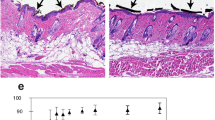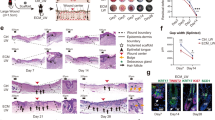Abstract
The ability to affect gene expression via topical therapy has profound therapeutic implications for conditions characterized by open wounds including cutaneous neoplasms, thermal injury, skin disorders and dysfunctional wound healing. Specifically targeting local gene expression avoids systemic toxicity and simplifies treatment. We have developed a new method of topical matrix-based short interfering RNA application to precisely and effectively silence local gene expression in nondelimited wounds.
This is a preview of subscription content, access via your institution
Access options
Subscribe to this journal
Receive 12 print issues and online access
$259.00 per year
only $21.58 per issue
Buy this article
- Purchase on Springer Link
- Instant access to full article PDF
Prices may be subject to local taxes which are calculated during checkout


Similar content being viewed by others
References
Fire A, Xu S, Montgomery MK, Kostas SA, Driver SE, Mello CC . Potent and specific genetic interference by double-stranded RNA in Caenorhabditis elegans. Nature 1998; 391: 806–811.
Elbashir SM, Harborth J, Lendeckel W, Yalcin A, Weber K, Tuschl T . Duplexes of 21-nucleotide RNAs mediate RNA interference in cultured mammalian cells. Nature 2001; 411: 494–498.
McCaffrey AP, Meuse L, Pham TT, Conklin DS, Hannon GJ, Kay MA . RNA interference in adult mice. Nature 2002; 418: 38–39.
Soutschek J, Akinc A, Bramlage B, Charisse K, Constien R, Donoghue M et al. Therapeutic silencing of an endogenous gene by systemic administration of modified siRNAs. Nature 2004; 432: 173–178.
Zimmermann TS, Lee AC, Akinc A, Bramlage B, Bumcrot D, Fedoruk MN et al. RNAi-mediated gene silencing in non-human primates. Nature 2006; 441: 111–114.
Zhang Q, Zhang ZF, Rao JY, Sato JD, Brown J, Messadi DV et al. Treatment with siRNA and antisense oligonucleotides targeted to HIF-1alpha induced apoptosis in human tongue squamous cell carcinomas. Int J Cancer 2004; 111: 849–857.
Bitko V, Musiyenko A, Shulyayeva O, Barik S . Inhibition of respiratory viruses by nasally administered siRNA. Nat Med 2005; 11: 50–55.
Dorn G, Patel S, Wotherspoon G, Hemmings-Mieszczak M, Barclay J, Natt FJ et al. siRNA relieves chronic neuropathic pain. Nucleic Acids Res 2004; 32: e49.
Zhang X, Shan P, Jiang D, Noble PW, Abraham NG, Kappas A et al. Small interfering RNA targeting heme oxygenase-1 enhances ischemia-reperfusion-induced lung apoptosis. J Biol Chem 2004; 279: 10677–10684.
Reich SJ, Fosnot J, Kuroki A, Tang W, Yang X, Maguire AM et al. Small interfering RNA (siRNA) targeting VEGF effectively inhibits ocular neovascularization in a mouse model. Mol Vis 2003; 9: 210–216.
Invitrogen Corporation. Agarose Ultra Pure, Material Safety Data Sheet. Invitrogen Corporation: Carlsbad, CA, USA, 2005.
Jiang M, Rubbi CP, Milner J . Gel-based application of siRNA to human epithelial cancer cells induces RNAi-dependent apoptosis. Oligonucleotides 2004; 14: 239–248.
Galiano RD, Michaels J, Dobryansky M, Levine JP, Gurtner GC . Quantitative and reproducible murine model of excisional wound healing. Wound Repair Regen 2004; 12: 485–492.
Dykxhoorn DM, Lieberman J . The silent revolution: RNA interference as basic biology, research tool, and therapeutic. Annu Rev Med 2005; 56: 401–423.
Darby IA, Bisucci T, Hewitson TD, MacLellan DG . Apoptosis is increased in a model of diabetes-impaired wound healing in genetically diabetic mice. Int J Biochem Cell Biol 1997; 29: 191–200.
Palliser D, Chowdhury D, Wang QY, Lee SJ, Bronson RT, Knipe DM et al. An siRNA-based microbicide protects mice from lethal herpes simplex virus 2 infection. Nature 2006; 439: 89–94.
Manoharan M . RNA interference and chemically modified small interfering RNAs. Curr Opin Chem Biol 2004; 8: 570–579.
Author information
Authors and Affiliations
Corresponding author
Rights and permissions
About this article
Cite this article
Thanik, V., Greives, M., Lerman, O. et al. Topical matrix-based siRNA silences local gene expression in a murine wound model. Gene Ther 14, 1305–1308 (2007). https://doi.org/10.1038/sj.gt.3302986
Received:
Revised:
Accepted:
Published:
Issue Date:
DOI: https://doi.org/10.1038/sj.gt.3302986
This article is cited by
-
Hydrogels for RNA delivery
Nature Materials (2023)
-
Percutaneous gene therapy heals cranial defects
Gene Therapy (2013)
-
Delivery Systems and Local Administration Routes for Therapeutic siRNA
Pharmaceutical Research (2013)
-
Therapeutic silencing of an endogenous gene by siRNA cream in an arthritis model mouse
Gene Therapy (2009)



